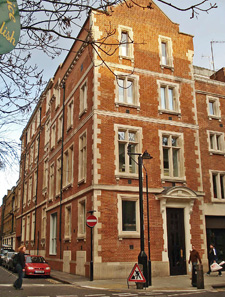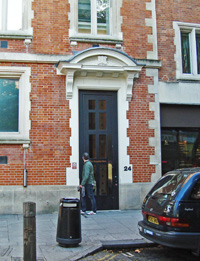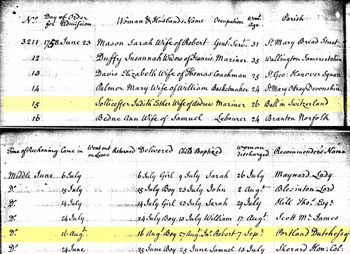Maternity
The oldest maternity hospital in London, the Lying-In Hospital for Married Women, opened at the end of 1749 with the Duke of Portland as its President. It had been established by a group of governors of the Middlesex Hospital, who were dissatisfied with the facilities available in that Hospital for women in labour. They purchased a house in Brownlow Street (now Betterton Street), off Long Acre, and furnished it with 20 beds.
The staff consisted of two physicians and two surgeons who practiced midwifery, a Matron skilled in the same, a chaplain, an apothecary, nurses and "other inferior servants".
Women were admitted in the last month of their pregnancy - they were only permitted to stay for three weeks - and needed a letter of recommendation from a subscriber (patients were not charged by the Hospital) and an affidavit of their marriage and their husband's settlement.
Patients received breakfast at 9 o'clock, lunch at 1 o'clock and supper at 7 o'clock. In the winter they went to bed at 8 o'clock and in the summer at 9 o'clock.
At the beginning of labour, the physician or surgeon in attendance would be called to judge whether the birth would be an easy natural one and could be left to the Matron to deal with, or would need continuing medical involvement.
From 1752 female pupils were admitted to learn midwifery, usually for a period of six months.
In 1756 the Hospital changed its name to the British Lying-In Hospital for Married Women to avoid confusion with the City of London Lying-In Hospital, which had opened in 1750, and the General Lying-In Hospital, which had been founded in 1752.
In 1828 the Hospital sent out midwives to deliver patients in their own homes. In 1849 it moved to a larger purpose-built building in Endell Street, the old building having been condemned by the District Surveyor. The new Hospital had cost £6,000 and had 40 beds.
By the beginning of the 20th century the Hospital was suffering from severe financial difficulties. It faced competition from the central London teaching hospitals, which had opened maternity wards, while its own local population was decreasing. The once new building had become old-fashioned and unsatisfactory. The governors were advised by the King Edward's Hospital Fund to amalgamate with another maternity hospital - preferably the Home for Mothers and Babies in Woolwich - rather than attempt to rebuild in the same area. Negotiations began and agreement was reached between the two Hospitals.
The Matron, nurses and other staff received gratuities in recognition of their service and the British Lying-In Hospital closed in May, 1913 (although legal difficulties delayed the signing of the Charity Commission Scheme's approval of the amalgamation until January 1915). Six of the first 14 members of the new Managing Committee for the amalgamated Hospitals, named the British Hospital for Mothers and Babies, were nominated by the British Lying-In Hospital.
Present status (December 2007)
The building became a military hospital during WW1. In 1919 it was bought by St Paul's Hospital for £15,000.
It is currently a club for private members - the Hospital.


The front elevation of the former Hospital in Endell Street.

In 1758, on 23rd June, Judith Esther Sollicoffer (aged 26), wife of Andrew, a mariner from the parish of "Gall" (St Gallen) in Switzerland, who was supposedly due to give birth in the middle of June (a recording mistake here?) was admitted on 16th August and delivered of a boy the same day. The boy was christened John Robert on 27th August and mother and baby were discharged on 7th September.
This was Judith's second delivery at the British Lying-In Hospital. In 1854, when her husband was working as a dyer, she had given birth to a daughter there; on that occasion, she was recommended by the Duke of Portland, President of the Hospital. This time the Duchess of Portland recommended her.
St Gallen, in the northeast of Switzerland, was well known for producing quality textiles. IN 1714 the yearly production was 38,000 pieces of cloth, but in the middle of the 18th century, when the Sollicoffers came to London, strong foreign competition and reforms in methods of cotton production had depressed trade there for a while.
This family of being researched by a 4 x great granddaughter, and the records of the Hospital provide crucial evidence in a fascinating story.
Judy Buckley, Bearsted
Black N 2006 Walking London's Medical History. London, Royal Society of Medicine Press.
Cody LF 2004 Living and Dying in Georgian London's Lying-In Hospitals. Bulletin of the History of Medicine 78, 309-348.
Croxson B 2001 The foundation and evolution of the Middlesex Hospital's lying-in service. Social History of Medicine 14, 27-57.
Ryan T 1885 The History of Queen Charlotte's Lying-In Hospital. Publisher unstated.
www.aim25.ac.uk
www.british-history.ac.uk
www.londonancestor.com
Return to home page